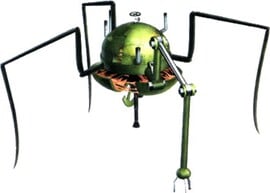| Man-at-Legs | |
|---|---|

| |
| Appears in | Pikmin 2 |
| Scientific name | Pseudoarachnia navaronia |
| Family | Arachnorb |
| Areas | None |
| Caves | Pikmin 2 Subterranean Complex Hole of Heroes |
| Challenge Mode stages | Secret Testing Range |
| 2-Player Battle stages | None |
| Attacks | Fires explosive projectiles |
The Man-at-legs is a member of the Arachnorb family, and first appeared as a boss in Pikmin 2. It's one of the few bio-mechanical creatures featured in the game, having a mostly mechanical torso sheathed in metal with four spindly legs - three of them are black, organic and spider-like, while the other one is mechanical. Several exhaust pipes on its body continually emit smoke. Unlike the other two Arachnorbs in the game, it has no flat footpads to stomp Pikmin with, but it can crush them occasionally with its big foot. Instead, it relies on its speed, quickly skittering around the room to avoid being attacked. When agitated, the panels of its underbelly separate and a machine gun-like weapon extends out, tracking any nearby targets via a laser before rapidly firing a barrage of explosive rounds at whatever it manages to lock onto. However, the Man-at-legs is not in control of this, the machine extendeds the machine gun, the Man-at-legs is actually gentle under the metal.
Once the Man-At-Legs dies, fireworks sprays from its body before the entire creature violently explodes, quite unlike the other two Arachnorbs, which simply disintegrate.
It is only found on the last sublevel of the Subterranean Complex, sublevel 13 of the Hole of Heroes and sublevel 2 of the Secret Testing Range in Challenge Mode.
Strategy
- When the creature has fully risen from the ground and starts aiming, the player should run for cover behind an object. Once it starts walking around, it should be chased. It is most easily attacked when it stands still and lowers its torso. When it shakes the Pikmin attacking it off in a fury, the player should hide again, and repeat the cycle.
- A large mob of Purple Pikmin thrown at this enemy while it lies dormant in the ground should drop its health to a substantial fraction. Once it has risen fully, the first or third strategy should be used.
- The creature is attacked until it has stood up all the way, and at that point it is petrified. As soon as the spray wears off, it should be petrified again. However, occasionally the Man-at-Legs will exit the stun and start shooting immediately, without the aiming laser.
- Before the creature opens fire, the player can dismiss their Pikmin away from the Man-at-Legs and run in tight circles around its legs. As long as Olimar is closer to the creature than the Pikmin he will be shot at, and with skill, unharmed. This strategy is easier to perform after obtaining the Rush Boots.
- The player can also make the Man-at-Legs turn opposite from its pedestal, then run underneath and attack on the slope of the pedestal, which makes it very easy to fight when in the watery battle stages. This tactic is best done with Blue Pikmin in both water stages and purples in the other stage.
- Unfortunately, the player faces the Man-at-Legs in a watery area two out of three times, leaving the aforementioned strategy of Purple Pikmin useless. In such circumstances it is best to attempt the "Hit and Run" technique of number one. The third strategy has also been removed in New Play Control! Pikmin 2, as the creature is invincible while it is rising from the ground. The fourth method is effective, but hard to perform at times.
Video
Gallery
- An artwork of a Man-At-Legs.jpeg
Concept artwork of a Man-at-Legs.
- MAL.png
A dormant Man-at-Legs in the Hole of Heroes.
Trivia
- Holes in its metal plating reveal "skin" with a texture similar to that of the Beady Long Legs. But the holes in the skin have a lava-like structure.
- Their scientific name, Pseudoarachnia navaronia, means 'Fake Spider of Navarone'. The second part of the scientific name, navaronia, is most likely a reference to the famous Guns of Navarone given the creature's weapon of choice.
- This enemy cannot be petrified while it is dormant.
- The name is a play on words of "man at arms", a professional soldier during the Middle Ages and possibly a "Portugese man o' war", a jellyfish-looking group of organisms.
